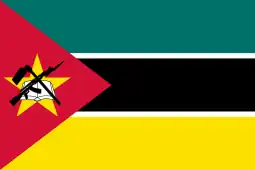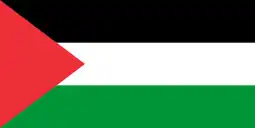| Zastava M55 | |
|---|---|
 M55 A4 B1 guns of the former Army of Republika Srpska | |
| Type | Towed 20 mm Anti-Aircraft Triple Autocannon |
| Place of origin | Yugoslavia/Serbia |
| Service history | |
| In service | 1955–present |
| Used by | See Operators |
| Wars | Yom Kippur War Angolan Civil War South African Border War Rhodesian Bush War Mozambican Civil War Lebanese Civil War Salvadoran Civil War Yugoslav Wars Second Nagorno-Karabakh war |
| Production history | |
| Designer | Zastava Arms |
| Designed | 1955–1971 |
| Manufacturer | Zastava Arms |
| Produced | 1971–present[1] |
| Variants | See Variants section |
| Specifications (Zastava M55) | |
| Mass | 1,100 kg (2,400 lb) loaded, 970 kg (2,140 lb) unloaded |
| Length | 1.47 m (4 ft 10 in) (driving condition) |
| Barrel length | 1,956 mm (77.0 in) L/70 |
| Width | 1.27 m (4 ft 2 in) (driving condition) |
| Height | 4.30 m (14.1 ft) (driving condition) |
| Crew | 6 -- gunners and commander |
| Shell | 20x110mm Hispano |
| Caliber | 20 mm |
| Barrels | 3 |
| Action | Gas operated |
| Elevation | +83° to -5 |
| Traverse | 360° |
| Rate of fire | 1,950 and 2,250 rpm cyclic, 700 rpm practical |
| Muzzle velocity | Armour-piercing: 840 m/s (2,800 ft/s), High-explosive incendiary: 850 m/s (2,800 ft/s) |
| Effective firing range | 2,000 m (6,600 ft) (air), 2,500 m (8,200 ft) (ground targets) |
| Maximum firing range | 4,000 m (13,000 ft) (vertical), 5,500 m (18,000 ft) (horizontal) |
| Feed system | 3 x 60 round top-fed drum magazines |
The Zastava M55, also designated 20/3-mm-M55, is a Yugoslavian/Serbian 20mm triple-barreled automatic anti-aircraft gun developed in 1955 and produced by Crvena Zastava (now Zastava Arms company) in Kragujevac, Serbia, for Yugoslav People's Army use and also for the export market. In addition to the basic towed model M55 A2, the variants M55 A3 B1, M55 A4 B1, and the BOV-3 SPAAG were also developed.
Development
In 1951, the Federal Secretariat of People's Defense (Serbo-Croatian: Savezni sekretarijat za narodnu odbranu – SSNO) purchased the manufacturing licence of the single-barrel Hispano-Suiza HS.804 20mm L/70 anti-aircraft autocannon mounted on the HSS.630-3 towed gun carriage. The HS.804 made by the Crvena Zastava Company entered production in 1955 as the Zastava 20/1mm M55 and the company's engineers began working in the development of a triple-barrelled version; the first prototype was completed and entered production in 1971.[2][3]
Variants
Ground model M55 A2

The standard towed version of the M55 introduced in 1971, is intended for infantry use.[4]
M55 A3 B1
The M55 A3 B1 is an improved version of the M55 A2 introduced in 1978.[4]
M55 A4 B1
The M55 A4 B1 was introduced in 1977–78, and is an M55 gun system mounted on the towed carriage of the Swiss GAI-D01 anti-aircraft gun. A new computer-controlled targeting system – the Galileo ballistic computer – was installed, which automatically monitors the gun after the target has been acquired. In addition, an engine of the same type as the M55 A3 B1 has been placed under the gunner's seat, which was moved from the lateral position found on the previous version in order to improve the weight distribution of the three barrels and prevent them from vibrating. When the cannon is put into position, the towed carriage is removed, and a small splinter-proof shield has been installed in front of the targeting device and the gunner.[4]
M55 A4 M1 (BOV-3)

The M55 A4 M1 was first introduced in 1983, and consists on a modified A4 B1 system upgraded with the Galileo J171 ballistic computer, mounted on a turret installed in the top roof of a BOV armoured personnel carrier.[4][2][3][5]
Combat history
Africa
The Zastava M55 A2 was employed extensively by the People's Armed Forces of Liberation of Angola (FAPLA) during the Angolan Civil War (1975–2002) and the later stages of the South African Border War (1966–1990), with a number of them being captured by the South African Defence Force during their military operations launched against SWAPO/PLAN guerrilla bases at southern Angola in the 1980s.[6] Some of the captured guns were stripped from the triple mounts and re-mounted on the Casspir APCs employed by the Koevoet on their counter-insurgency operations in Angola and South West Africa[7] whilst others were handed over to the Armed Forces of Liberation of Angola, the armed wing of UNITA.
The Zastava M55 was also employed by the People's Forces of Liberation of Mozambique (FPLM) during both the Mozambican Civil War (1977–1992) and the later phase of the Rhodesian Bush War, with a few guns falling into the hands of the Rhodesian Security Forces in the course of their covert cross-border raids on Zimbabwe African National Liberation Army (ZANLA) guerrilla training camps in Mozambique during the late 1970s.[8]
Middle East
Lebanon received an unspecified number of Zastava M55 A2 autocannons sometime in the early 1970s from Yugoslavia, which were assigned to the air defense units of the Lebanese Army and the Lebanese Air Force.[9] They were extensively employed during the Lebanese Civil War (1975–1990), with several guns falling into the hands of the various competing Christian and Muslim militias after the collapse of the Lebanese Armed Forces in January 1976. Main operators included the Army of Free Lebanon,[10] Lebanese Arab Army,[11] Al-Tanzim, Kataeb Regulatory Forces,[12] Zgharta Liberation Army, the Tigers Militia, Arab Socialist Union,[13] the Druze People's Liberation Army,[14][13] the Al-Mourabitoun,[15][16][17] and the Palestine Liberation Organization[18] who mounted their Zastava M55 autocannons on technicals and M113 armored personnel carriers.[19][12][16][20]
2020 Nagorno-Karabakh War
Azerbaijan's Ministry of Defence reported that it destroyed two Armenian Zastava M55s 9–10 October 2020 as part of the 2020 Nagorno-Karabakh war.[21]
Operators
 Armenian Armed Forces[21]
Armenian Armed Forces[21] Angolan Armed Forces[22][23]
Angolan Armed Forces[22][23] Armed Forces of Bosnia and Herzegovina[24]
Armed Forces of Bosnia and Herzegovina[24] Armed Forces of the Democratic Republic of the Congo[25]
Armed Forces of the Democratic Republic of the Congo[25] Army of the Republic of North Macedonia[26]
Army of the Republic of North Macedonia[26] Croatian Army
Croatian Army Cyprus National Guard
Cyprus National Guard Guatemalan Armed Forces
Guatemalan Armed Forces Indonesian Air Force Paskhas corps, 55 M55 A2 units. still in limited service.[27]
Indonesian Air Force Paskhas corps, 55 M55 A2 units. still in limited service.[27] Mozambique Defence Armed Forces
Mozambique Defence Armed Forces Salvadoran Army[28]
Salvadoran Army[28] Serbian Army
Serbian Army Slovenian Armed Forces
Slovenian Armed Forces Tunisian Army[29]
Tunisian Army[29]
Former operators
 Armed Forces of Liberation of Angola (UNITA) – Handed over by South Africa or captured from FAPLA.
Armed Forces of Liberation of Angola (UNITA) – Handed over by South Africa or captured from FAPLA. Artsakh Defence Army − Seized by Azerbaijan after the 2023 Azerbaijani offensive in Nagorno-Karabakh[30]
Artsakh Defence Army − Seized by Azerbaijan after the 2023 Azerbaijani offensive in Nagorno-Karabakh[30] Kuwait Army - Used in the Arab-Israeli Wars.
Kuwait Army - Used in the Arab-Israeli Wars. Lebanese Armed Forces – Retired (now used for training purposes only).
Lebanese Armed Forces – Retired (now used for training purposes only)..svg.png.webp) Rhodesian Security Forces – Captured from FPLM or ZANLA.
Rhodesian Security Forces – Captured from FPLM or ZANLA. Palestine Liberation Organization – Captured from the Lebanese Armed Forces.[18]
Palestine Liberation Organization – Captured from the Lebanese Armed Forces.[18].svg.png.webp) South African Defence Force – Captured from FAPLA.
South African Defence Force – Captured from FAPLA. Syrian Armed Forces
Syrian Armed Forces.svg.png.webp) Yugoslav People's Army and Territorial Defense – passed on to successor states.
Yugoslav People's Army and Territorial Defense – passed on to successor states.
See also
References
- ↑ "Zastava Arms".
- 1 2 Miroslav Jandrić, Seventh Decade of the Military Technical Institute (1948. – 2013.), Scientific Technical Review, 2013, Vol. 63, No. 2, pp. 5–25. UDK: 355.014:623.4, COSATI: 15–05, 19–06, 01-03, p. 9.
- 1 2 "1945 – 1970 | Zastava-arms". www.zastava-arms.rs. Retrieved 2017-07-13.
- 1 2 3 4 "1970-1992 | Zastava-arms". www.zastava-arms.rs. Retrieved 2017-07-13.
- ↑ Foss, Christopher F. (2002). Jane's Tank & Combat Vehicle recognition guide. London: HarperCollins. pp. 298–299. ISBN 0-00-712759-6.
- ↑ Venter, War in Angola (1992), pp. 7; 9.
- ↑ Heitman & Hannon, Modern African Wars (3): South-West Africa (1991), p. 22.
- ↑ Photos of Zastava M55 autocannons captured by the Rhodesian Security Forces in Mozambique, September 1979.
- ↑ Kassis 2012, p. 15.
- ↑ Sex & Abi-Chahine 2021, p. 173.
- ↑ Lebanese Arab Army M113 APCs with ZU-23-2 and Zastava M55 autocannons
- 1 2 Kassis 2003, p. 27.
- 1 2 Kassis 2019, p. 233.
- ↑ Leigh Neville, Technicals: Non-Standard Tactical Vehicles from the Great Toyota War to modern Special Forces, New Vanguard series 257, Osprey Publishing Ltd, Oxford 2018. ISBN 978-1-4728-2251-2, p. 15.
- ↑ Kassis 2003, p. 66.
- 1 2 El-Assad, Moustafa (2008). Civil Wars Volume 1: The Gun Trucks. Sidon: Blue Steel books. p. 93. ISBN 978-9953-0-1256-8.
- ↑ Zastava M55 autocannon of the Al-Mourabitoun militia in the Lebanese civil war
- 1 2 Sex & Abi-Chahine 2021, p. 157.
- ↑ Jureidini, McLaurin, and Price, Military operations in selected Lebanese built-up areas (1979), appendix A, table A-6.
- ↑ Kassis 2012, p. 53.
- 1 2 "Baku reports intensive fighting in Karabakh throughout night". TASS. Retrieved 2021-09-14.
- ↑ "Angolan Army Equipment". Globalsecurity.org.
- ↑ "Angolan army land ground forces military equipment armoured vehicle pictures information desc - Army Recognition".
- ↑ "Bosnia Herzegovina Land Forces military equipment, armament and vehicles Army" armyrecognition.com
- ↑ Wondo Omanyundu, Jean-Jacques (23 May 2018). "Joseph Kabila continues to over-equip his regime militarily for the upcoming political deadlines". desc-wondo.org.
- ↑ Army of the Republic of Macedonia official site
- ↑ "Perawatan triple gun Paskhas". Facebook. Retrieved 2021-11-06.
- ↑ "El Salvadoran Army index equipment" armyrecognition.com
- ↑ Tunisian Army modified GMC M35 Trucks with Zastava M55 Triple 20 mm Anti-Aircraft Autocannons.
- ↑ Mitzer, Stijin; Oliemans, Joost. "Documenting Equipment Losses During The September 2023 Nagorno-Karabakh Conflict". Oryx. Retrieved 7 October 2023.
Bibliography
- Helmoed-Romer Heitman & Paul Hannon, Modern African Wars (3): South-West Africa, Men-at-arms series 242, Osprey Publishing Ltd, London 1991. ISBN 978-1-85532-122-9
- Kassis, Samer (2003). 30 Years of Military Vehicles in Lebanon. Beirut: Elite Group. ISBN 9953-0-0705-5.
- Kassis, Samer (2012). Véhicules Militaires au Liban 1975-1981 [Military Vehicles in Lebanon 1975-1981]. Chyah: Trebia Publishing. ISBN 978-9953-0-2372-4.
- Kassis, Samer (2019). Invasion of Lebanon 1982. Abteilung 502. ISBN 978-84-120935-1-3.
- Paul Jureidini, R. D. McLaurin, and James Price, Military operations in selected Lebanese built-up areas, 1975-1978, Aberdeen, MD: U.S. Army Human Engineering Laboratory, Aberdeen Proving Ground, Technical Memorandum 11–79, June 1979.
- Sex, Zachary; Abi-Chahine, Bassel (2021). Modern Conflicts 2 – The Lebanese Civil War, From 1975 to 1991 and Beyond. Modern Conflicts Profile Guide. Vol. II. AK Interactive. EAN 8435568306073.
- Venter, Al J. (1992). War in Angola. Hong Kong: Concord Publications. ISBN 962-361-030-0.